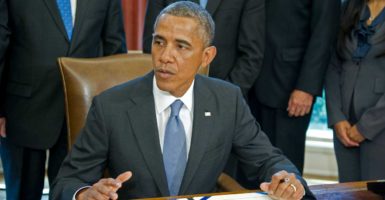President Barack Obama greatly increased financial assistance for college students since 2008, but the cost of higher education and student debt still climbs and graduation rates have remained flat.
In the 2007-2008 academic year, the average combined tuition and fees for public four-year colleges and universities were $15,530, according to the College Board, a higher education survey group. By the 2015-2016 academic year, that price increased to $19,550.
“One of the biggest drivers for the increase in costs for students and families has been disinvestment by states in public higher education,” @JohnKingatED says.
For private colleges and universities, the price rose from an average of $36,660 in 2007-2008 to $43,920 in academic year 2015-2016.
Education Secretary John B. King Jr. said states deserve much of the blame for increasing costs.
“One of the biggest drivers for the increase in costs for students and families has been disinvestment by states in public higher education,” King told The Daily Signal during the White House press briefing Thursday, adding:
So if you look across the last 20 years, you see many states where investment levels in public higher education are flat or even going down. Those costs, of course, are passed along to students and families.
However, the Center for College Affordability and Productivity, a conservative higher education think tank, contends the boost in financial assistance is an excuse and a disincentive for colleges to keep costs down. A 2014 study by the organization says:
They [federal subsidies] have significantly contributed to tuition price inflation, the proceeds of which have helped fund an unproductive and costly academic arms race …
By returning the programs to what they were early in their history—modest but useful financial support to truly needy students—it will moderate tuition price inflation and reverse the decline in academic standards. It will contribute to returning the nation to fiscal responsibility while improving the nation’s higher-education system.
Richard Vedder, director of the Center for College Affordability and Productivity, said the increase in loans and grants has certainly been a legacy of the Obama administration.
However, Vedder said, Obama is not entirely to blame because federal assistance to education has been on a steady increase since 1978—with generally poor results.
“Federal student loan programs lead to higher tuition and fees, and the benefit goes to the universities themselves more than students,” Vedder told The Daily Signal in a phone interview. “Pell Grants have greatly expanded, and a large number of Pell Grants are not for poor students. They’re not going to rich students, but still to students well above the poverty line.”
The Obama administration raised the maximum Pell Grant award to $5,730 in 2014, about $1,000 higher than it was in 2008.
The number of Pell Grant recipients increased by about 50 percent, according to the White House. And the “Pay as You Earn” program allows about 1.6 million students to cap the repayment of student loans to 10 percent of their monthly income.
The White House also launched the “Race to the Top” program for college affordability that would tie federal aid to college efforts to keep tuition prices down.
Though critical of the Obama administration’s attempt to lower tuition costs, Vedder credits the Department of Education for instituting a “College Scorecard,” which provides information to aspiring students on a school’s graduation rates, job placement, and average pay in particular occupations.
Many colleges and universities added the most fees in the aftermath of the recession, to draw more revenue, Vedder said.
Even after the government takeover of the student loan industry, 43 percent of individuals with federal student loans this year—about 9.3 million—were in default, delinquent, or postponed payments, The Wall Street Journal reported earlier this year.
Fewer than 19 percent of full-time students attending public universities earn bachelor’s degrees in four years, while just 36 percent of students attending public, research-based institutions earn a degree in four years, according to a study by The Heritage Foundation.
The Heritage study cited research from Northwestern University that found most full-time students don’t take the needed 15 credits per semester to graduate in four years.
Obama was scheduled to speak Friday at Annandale High School in Annandale, Virginia, ahead of Oct. 1, which is the first opportunity for students to submit the Free Application for Federal Student Aid for the 2017-2018 academic year. However, he canceled the speech to attend the funeral of former Israeli Prime Minister Shimon Peres.
King was part of the White House’s daily press briefing, and talked about various education issues.
“One of the things we’ve tried to do to ensure college affordability and help people manage their debt is the president’s repay effort, where we use income-driven repayment so that your payments on student debt are capped at about 10 percent of your income,” King, Obama’s education secretary, told The Daily Signal. “We are seeing that having an effect on the number of folks defaulting. It is bringing down the number of defaults. So we are making progress there.”
The most recent government numbers, as of 2008, from the National Center for Education Statistics show that 60 percent of college students ultimately graduate with a bachelor’s degree within six years or less.
“Certainly increasing college completion is part of solving the affordability puzzle,” King told The Daily Signal. “We know that folks who don’t finish school are dramatically more likely to default on their debt.”



























